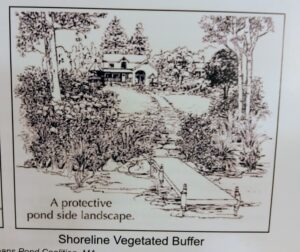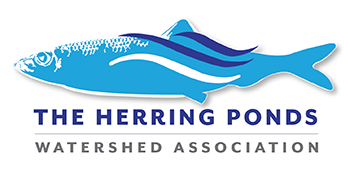The Importance of a Vegetated Buffer
 By Geri Williams
By Geri Williams
A vegetated buffer is a protective area of trees, shrubs and other plants between a waterbody and human activity. It is a “living filter”, because it captures many of the pollutants that travel through. These pollutants include sediment, sand, salt, oil, gas, antifreeze and other pollutants from roads and driveways; pesticides and fertilizers from home gardens and lawns; and trash, pet droppings and other debris. Phosphorus, the pollutant of particular concern for increasing algae and cyanobacteria blooms in fresh water bodies, is one of these pollutants.
The way vegetated buffers work is by dispersing and slowing down rain and the flow of surface water. They trap sediment, extend retention times and increase the rate of infiltration. A large amount of the phosphorus that reaches our freshwaters is adhered to sediment. The longer that runoff is in contact with the soil, the more time that plants and soil microorganisms have to absorb and transform pollution into less harmful forms.
The Regulations of the Plymouth Conservation Commission established a “No touch zone” buffer of 35 feet from the edge of ponds, streams, wetlands and coasts. This means that to protect these waterbodies residents who own property alongside a pond, stream, etc. cannot make any changes on their property within 35ft of the water edge. This includes removing trees and shrubs, adding sand, retaining walls or pathways and stairs without prior approval of the Conservation Commission. Regulations also provide protections for land up to 100 feet from the edge of the water or wetland. An allowable exempt activity is judicious view pruning. This does not permit the removal of trees, but allows the removal of select branches to open up the canopy and improve the view. The rules are there to protect our environment and enhance the quality of life and enjoyment for all of us.
Recent harmful cyanobacteria blooms in Great Herring Pond have closed our pond and restricted our recreational activities. It is excess phosphorus that allows the cyanobacteria, which are always present at low levels, to grow exponentially to toxic levels. It is especially important that those of us who border the ponds and streams in our watershed do not remove the trees and shrubs along the water’s edge. What we do on our property directly affects the pond or stream we live on, and thus we are caretakers not only of our own yard, but of the pond or stream itself.
If you witness someone cutting vegetation along a pond or stream, take a picture with your phone and call the Plymouth Conservation agent Richard Vacca 508-747-1620 x10140
If the plants have already been removed we should plant native trees, shrubs and other plants to establish a vegetated buffer. Some good native trees to use are oaks, black cherry, various birch, red and sugar maple, and shadbush or Amelanchier. Some of the native shrubs already growing beside the ponds that provide high nutrition for birds and insects are blueberry, swamp azalea, inkberry holly, sweet pepperbush and black chokeberry. But also attractive to use are red osier and grey dogwood, willows, mountain laurel, and various native viburnums. A grass lawn is not effective at reducing runoff, and if you add fertilizer to maintain it you are adding to the problem.

Green buffers or plantings also prevent shore erosion, add beauty to our yards, preserve habitat for birds and wildlife, and discourage geese from crossing them to graze on our lawns – just as the original, undeveloped shoreline did.
What else can I do?
- Conduct a Rainy Day Survey of your property. This will help you determine runoff problems and prioritize improvements. Place your buffer plants in the path of the stormwater runoff.
- Minimize exposed soils, especially along the water’s edge. Revegetate eroded areas like dirt paths, bare slopes and exposed tree roots.
- Do not allow mowed grass, leaves and yard waste to enter the water. They are easily broken down and the nutrients can cause algal blooms.
- Avoid paved or straight paths from your home to the shoreline. Instead create a curved path that reduces velocity of runoff water rushing downhill.

Thanks for this very informative article. It was especially helpful to have a set of actions each of us can take to protect our environmental resources.